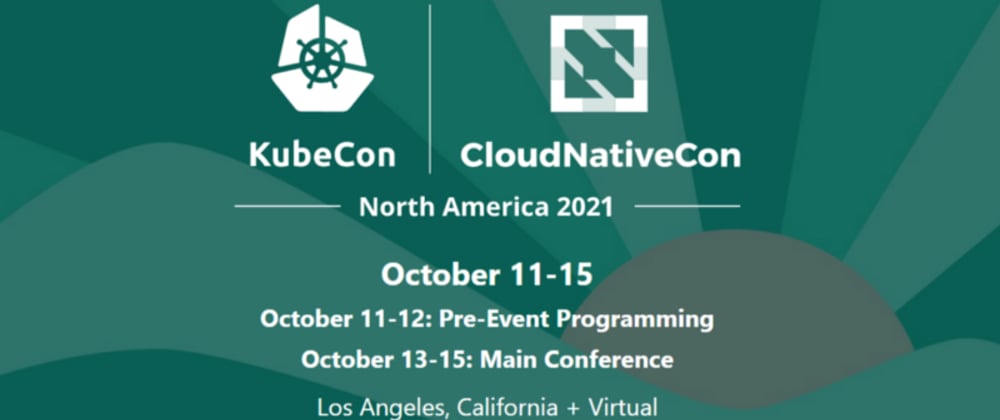KubeCon is only a few weeks away, and the excitement among prospective participants is building up. This is one of the significant events in the world of tech that is finally going face-to-face after the pandemic restricted social gatherings. It has a virtual component, but it will be mainly an in-person event to be held at the Los Angeles Convention Center in Los Angeles, California.
Big names in the world of cloud computing such as CoreDNS, Fluentd, Envoy, Open Policy Agent, Prometheus, Just Containerd, Argo, OpenTracing, Operator Framework, Rook, NATS, Linkerd, SPIFFE, SPIRE, Thanos, Dragonfly, Cortex, CloudEvents, KubeEdge, and Kubernetes are expected at the five-day event starting on October 11 and culminating on the 15th. The first two days are designated for pre-event programming and the main event is on the latter three days, which will feature breakout sessions, sponsor showcase, and keynotes.
There are many tracks and contents to look forward to in KubeCon 2021, and it would be interesting to find out how the recent trends in cloud computing will be discussed at the event.
Efficient Kubernetes-native troubleshooting
According to a Gartner prediction, 3 in every 4 midsize and large organizations will already be employing a hybrid or multi-cloud strategy. This entails the growing importance of Kubernetes as it enables application portability, which in turn helps in boosting the productivity of developers and fostering innovation. However, the rise of Kubernetes also comes with inevitable problems or issues, hence there is a need for effective Kubernetes troubleshooting.
Monitoring changes in the entire Kubernetes stack requires specialized skills particularly in the effective analysis of ripple effects and context-based approach in troubleshooting problems. A K8s-native troubleshooting solution like Komodor ensures that the troubleshooting process is undertaken in an independent and efficient manner. It institutes systematization to address the chaos that is usually present when there are many people and actions involved in the process.
Kubernetes-native troubleshooting simplifies the whole process significantly while delivering the right level of K8s visibility. It ensures that everyone in the team understands Kubernetes as used in their specific environment and provides a robust end-to-end tracking system. In the case of Komodor, this kind of monitoring enables data viewing not only from configuration and alerts but also from Git, the enterprise infrastructure, and other tools used by an organization.
“When you have an incident with your infrastructure, they end up on this kind of treasure hunt trying to figure out what changed, what happened, what went wrong. Komodor says: ‘Let me actually abstract away a lot of this complexity and serve up the answer about what changed in a single pane of glass and help you troubleshoot just far more efficiently than you were able to do … in the past,” explains Seth Pierrepoint, a partner at Accel, a major investor supporting Komodor.
Komodor is participating in KubeCon 2021. Participants who need more insights about effective and efficient K8s-native troubleshooting can definitely pick a thing or two from the company as they prepare for the issues they may encounter with their Kubernetes adoption.
Bringing air gapping and Kubernetes together
Air gapping and the security infrastructure do not meld well especially with microservices in the picture. Having highly segregated networks, which are usually intended to protect sensitive systems, can be an obstacle to securing processes. Organizations may need to replicate their security infrastructure across networks. When using vulnerability assessment tools, for example, organizations will have to update their scanners to cover isolated networks. Security information and event management (SIEM) systems may also need to be reconfigured.
Things get even more complex with the microservices infrastructure in the picture. Making Kubernetes operate in air-gapped environments is a highly complicated task. There are infrastructure limitations to take into account, which can be highly restrictive when it comes to effective deployment and operation. Organizations will have to employ additional infrastructure and more dependency planning to ensure that Kubernetes works in the midst of air gapping.
The good thing is that there are solutions designed to make it easy to bring K8s and air gapping together. Klusterkit, for example, simplifies the deployment and operation of Kubernetes in on-prem and air-gapped environments. It is a toolkit consisting of three independent tools, which can be used separately or together to efficiently manage the lifecycle of a Kubernetes cluster. It also enables quick recovery from failures through an etcd backup while providing rolling upgrade and rollback capabilities.
KubeCon 2021 is expected to feature various sessions that will help enterprises gain more knowledge and insights on accelerating delivery without making compromises on their security. Likewise, these sessions can offer guidance on achieving not only consistent but also highly resilient and adequately protected cloud-native systems.
Edge computing and the Internet of Things
If air gapping can be troublesome for Kubernetes, edge computing and IoT are in the opposite position. They are compatible with the microservices infrastructure. They can be characterized as ideal for computing scenarios that require the ability to quickly deploy new functions and updates while computing near or at the source of the data itself.
The number of IoT devices worldwide is projected to reach 46 billion in 2021. Meanwhile, the edge computing market is set to grow at a compounded annual growth rate of 38.4 percent from 2021 to 2028. These growths are incidentally fueling the growth of the microservices infrastructure or Kubernetes in particular. Logically, enterprises need to learn how to make the most out of IoT and edge computing innovations for their business operations as they embrace containerized workload technology and the microservices infrastructure.
Amazon offers something similar to the open source Kubernetes, which serves as a master tool for the management of containerized systems applicable to settings that involve various IoT devices and edge computing. Called the Amazon Elastic Container Service for Kubernetes, it facilitates the standardization of operations across environments. It also ensures the efficient provisioning and scaling of resources while improving availability and observability.
KubeCon 2021 will have many sessions and keynotes that will introduce enterprises to the latest innovations in the world of cloud-native computing and Kubernetes as they are used in ecosystems that involve edge computing and various Internet of Things devices. The quickly evolving digital landscape presents new technologies and systems that will be significantly useful to businesses, so it makes perfect sense to get acquainted with them and try to leverage them for business success.
Artificial intelligence
AI and machine learning will continue to become a big part of technological evolution in the next decades. Artificial intelligence still has a lot of room for growth and is far from perfect even though it is already being employed in a plethora of applications. Kubernetes or containerization happens to have an important role to play in AI's progress.
As Red Hat puts it, “containers and Kubernetes are key to accelerating the ML lifecycle as these technologies provide data scientists the much needed agility, flexibility, portability, and scalability to train, test, and deploy ML models.” Containers can help address the challenges encountered in AI and machine learning modeling, execution, and deployment.
An excellent example of a Kubernetes solution for artificial intelligence development is Red Hat OpenShift Data Science. This managed cloud service is specifically designed for data scientists and developers focusing on intelligent applications. Essentially, it works like a sandbox through which developers can rapidly develop, train, and evaluate machine learning models. The machine learning models created using this tool are made to be portable to other platforms to ensure rapid deployment on containers and in the hybrid cloud.
Organizations looking to polish or further improve AI-driven products and solutions with the help of container technology can find many interesting sessions at KubeCon. There are breakout sessions and keynotes that share new knowledge and insight on the use of Kubernetes in solving the many challenges that emerge during AI and ML modeling and deployment.
In summary
Kubernetes has been steadily gaining popularity and its technology continues to advance. KubeCon 2021 is an exciting event to learn more about container technology and how it is finding applications in many areas. The advancement of cloud-native computing ushers myriad benefits not only for businesses but for various other settings. It makes perfect sense to know more about it and be part of its evolution through an event like KubeCon.
Image: Pexels








Oldest comments (0)